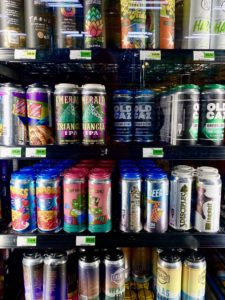Beer cans have come a very long way since 1935 – when the first successful beer can was created by “American Can” and the Gottfried Krueger Brewing Company of New Jersey – who first delivered 2,000 cans of Krueger’s beer to Virginia. In 2023 the beer can is now a staple on the shelves of beer stores and grocery stores across the nation. Most everyone knows that beer cans are superior to bottles for storing beer (impervious to light and air, lighter and easier to store and ship) but many don’t know that the 90 year history of the beer can helped shape the beer industry and beer appreciation as we know it.
The first cans were produced after the end of prohibition and can manufacturers tried various ways to seal in beer under pressure as well as maintain at least a reasonable flavor. Steel cans were developed at first – some with flat crimped tops, other with “cone tops” that could be capped like a beer bottle. Cans popularity increased with World War II as canned beer was more easily shipped out to the troops. But, from 1942 – 1947 beer cans production ceased due to metal shortages that were a by-product of the war.
As the beer industry emerged for a series of near mortal blows – first prohibition from 1920 – 1933, then the Great Depression in 1939, and finally the War in 1942; a lot had changed from the old community-based brewery model that had been in place prior to 1920. New methods of mass production – jump started by WW II along with related advances in shipping, the establishment of a national rail system and refrigeration enabled larger brewers to build out their scale. As they grew larger, they bought out (or squeezed out) most of the smaller local community breweries. And the beer can was part of that change – they were lighter, stackable, longer lasting than bottles – but at the time only very large breweries with enough size and revenue could afford to use them.
 As post prohibition war weary Americans embraced lighter lagers in cans, the market for canned beer exploded. And the can itself continued to evolve to even more convenience – addressing the big issue of getting the darn things open. “Where’s my can opener?” was the 1950’s version of today’s “Where’s my phone?” Something had to be done. In 1963, the first pull tab beer cans appeared on the market as Pittsburgh Brewing Company used the first pull tab cans for Iron City Beer – and consumers quickly adopted it.
As post prohibition war weary Americans embraced lighter lagers in cans, the market for canned beer exploded. And the can itself continued to evolve to even more convenience – addressing the big issue of getting the darn things open. “Where’s my can opener?” was the 1950’s version of today’s “Where’s my phone?” Something had to be done. In 1963, the first pull tab beer cans appeared on the market as Pittsburgh Brewing Company used the first pull tab cans for Iron City Beer – and consumers quickly adopted it.
The story has it that Schlitz introduced the mass production finger-loop pull tab introduced in 1965, and finally in 1969, canned beers sold in the United States overtook bottled-beer sales. (Talk about your “summer of beer love”). I can still recall walking down busy streets in boyhood Durham, North Carolina and seeing the metal pull tables strew along the sides of the road. It was definitely not fun to find them on the beach with your bare feet.
In the 70’s the “pop top” beer can was finally invented, and while there were some different designs, we have essentially the same type today. Do you recall the early “Coors” yellow cans, with the small hole and large hole tabs on top to pop? That was so cool, and added to that beer’s mystique in the 70’s and 80’s. Lined aluminum cans replaced steel, making them even easier to deal with. But, the beer can was still the domain of the hugest brewers only – and associated with Miller, Bud, Pabst lagers – symbolic of “your Father’s beer”.
 As the craft beer scene evolved in the early 80’s – they were all bottled, as after all – most of these breweries started from humble home brewing roots. They were still manually capping their bottles, sometimes even reusing old ones. The very idea of canning craft beer was not only emotionally contrary to the “edginess” of new craft, but was financially out of reach of smaller brewers who didn’t have the size or scale to invest in a canning line and equipment. So, the small community of craft brewers evolving in the 80’s went back to the pre-prohibition model of selling their beers locally and only in bottles.
As the craft beer scene evolved in the early 80’s – they were all bottled, as after all – most of these breweries started from humble home brewing roots. They were still manually capping their bottles, sometimes even reusing old ones. The very idea of canning craft beer was not only emotionally contrary to the “edginess” of new craft, but was financially out of reach of smaller brewers who didn’t have the size or scale to invest in a canning line and equipment. So, the small community of craft brewers evolving in the 80’s went back to the pre-prohibition model of selling their beers locally and only in bottles.
Most craft beer fanatics can recall the first time they saw craft beer in a can, and in most cases (pardon the expression) it was Oskar Blues in 2002 with “Dale’s Pale Ale”. While it was considered more or less a marketing gimmick at first, soon the younger, environmentally conscious craft beer drinkers realized that canned beer was better for the ecology, had a lower carbon footprint and could be consumed on a hike or at the beach following the “pack it in pack it out” mantra. It didn’t hurt that Dale’s Pale ale was also very good and got national recognition.
Seeing a new business opportunity, new smaller more affordable canning lines were soon developed and “gypsy canners” started to offer mobile on-site canning services to smaller brewers. After about 2010 canned craft beer was the preferred package of brewers and craft beer consumers as well. Ironically, the larger brewers saw the economic benefits and change of consumer preference – and shifted more of their production back to cans as well.
Even today, the “tall boy” pint can is the preference of many beer drinkers – particularly craft, but for macro lager imbibers as well. A lot of the newest generation of beer drinkers now embrace the good old beer can as being symbolic of “throwback O.G. beers” like Pabst and Bud. Those beers are perceived to be “easy to drink” and are certainly cheaper for younger budgets than most more typical craft beer. A relatively new developing trend in craft is to develop and can throwback light lagers made with corn additions and label them as “Old Original Lager” or something similar.
As consumers become more concerned with their contribution to carbon levels – and have increased interest in recycling and reuse, the aluminum can has become the package of choice for all drinks. Canned coffee, cocktails, wine and even water are the preferred way to buy drinks today, which has created some aluminum can shortages and sourcing difficult to some of the smaller brewers.
So, what comes around goes around, what is old is new again. Grab a tall boy – of craft IPA or “old style” light lager – pop the top and let’s give cheers to the beer can – 90 years young and still going strong.









